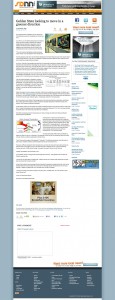This story was reported for San Diego News Network on April 22, 2009.

Two proposed pieces of legislation look to change what TVs Californians use and the windshields on the cars they drive.
In an effort to turn the Golden State greener, the California Energy Commission (CEC) is proposing to implement energy efficiency standards for televisions, while the California Air Resources Board (CARB) is proposing legislation that would enforce cars sold in-state to use windshields that contain a certain amount of reflectivity.
“This is our chance to fight global warming and reduce carbon dioxide,” CEC spokesperson Adam Gottlieb said.
The first proposal by CEC falls in line with Section 254202 (c) of the Public Resources Code which requires CEC to improve energy efficiency in the state. If the legislation is passed, televisions offered for sale in California would have to adopt new energy efficiency standards.
As of now, 10 percent of an average home electricity bill is consumed by televisions, whereas if efficiency standards were implemented the percentage may be reduced by a fraction. Televisions have “become standard in every living room or family room” in the last 30 years, which in turn, creates an estimate of 35 million TVs in California, which consume 8,772 gigawatt hours annually. A gigawatt hour is equivalent to having 40,000 televisions on for five hours a day for one year, according to CEB.
Gottlieb said the proposal can save consumers $18 to nearly $30 per year per television. The proposal, which the state legislators are expected to vote on in the summer, will aim to cut energy consumption of televisions by 33 percent in 2011 in the first tier and by 49 percent in 2013 in the second tier (see chart).
“We have similar standards on refrigerators, washers, dryers and even cell phone chargers but not televisions,” Gottlieb said. “Thirty years ago when many were against the restrictions on refrigerators – they didn’t have as many features. Now, we have refrigerators with ice makers, fountains – and they all use half the energy they did 30 years ago.”
Despite the urgency to reduce energy consumption, California has actually become the leader on efficient use of energy. Since 1979, energy consumption in the state has remained constant regardless of the growing population (22 million in 1979 to 38 million in 2008). CEC reports find that California uses 7,000 kilowatt-hours per capita while the rest of the country uses 12,000 per capita – increasing by 40 percent in the same period.
But Doug Johnson, senior director of technology policy at the Consumers Electronics Association, said Energy Star, a federal government program, already maintains the necessary standards on televisions among other products, which makes the proposal unnecessary.
He said another reason why the proposal isn’t needed or feasible because it forces the state market to “take a step back.” He said the standards would force businesses to create fewer televisions. This in turn, may cause the state to lose $50 million in tax revenue and may reduce up to 4,600 jobs.
While CEC is proposing a plan that would reduce our intake of energy, the California Air Resources Board is proposing greener windshields.
The proposal is in response to Assembly Bill: 32 California’s Global Warming Solutions Act of 2006 that requires the state to reduce Greenhouse Gas Emissions by 25 percent, essentially bringing California back to 1990 levels by 2020. The proposal asks for “window glazing” requirements that would better reflect the solar spectrum. This would then allow the car to be cooler (see chart) which eventually, allows the driver to use the air conditioner less – or so the board hopes.
The exact percentage CARB is asking windshields to reflect and utilize from the sun is 30 percent. This essentially, would cost the car manufacturer about $10 to $30 more per vehicle, according to spokesperson Stanley Young.
“I don’t think anyone is against it [the proposal],” Young said. “The reflectivity requirement would be simple to enact and is completely invisible to both the people inside the car and outside the car.”
Previously, CARB also proposed to force manufacturers to use cars with cooler paints since dark-colored cars become hotter in the sunlight, and thus, may cause the driver or passenger to turn up the air-conditioning. However last month, CARB canned the idea. Young said it just wasn’t the right time for California.
If passed, the legislation will be enacted in 2012.
To Al Sweedler, director of energy studies at San Diego State University – both legislation pave the path that California needs to take.
“They’re both very good ideas,” Sweedler said. “California remains at a constant energy usage level and these plans will ensure that it remains constant.”
He said that the idea of requiring energy-efficiency standards for televisions is feasible and simple. And, that the average Californian would be happy with its result since it ultimately reduces the electricity bill. As for the car proposal, in regards to changing car colors, he agrees that it wouldn’t be feasible.
“I strongly encourage more reflective coating for all paint colors,” Sweedler said. “But, I also wouldn’t outlaw certain colored cars.”
“Then it will all become political.”
Hoa Quach is the political editor for the San Diego News Network.
